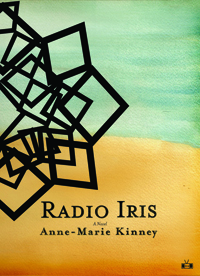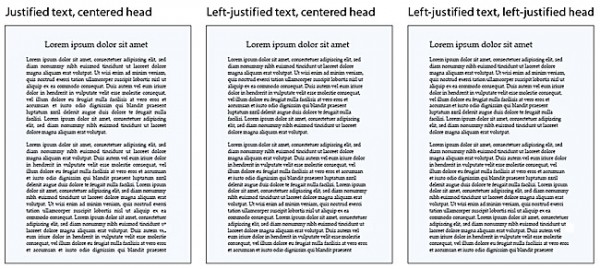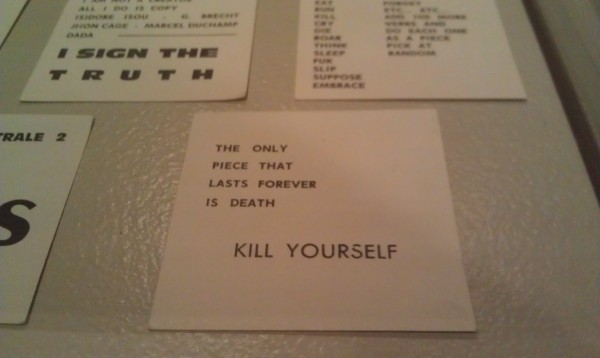Meanwhile, There Are Things to Read and Know
B.J. Hollars wrote a really moving essay about his friendship with Ray Bradbury.
There’s a new poet laureate and she’s not super old! Her name is Natasha Trethewey.
Here’s an interview with Ben Lerner over at The New Yorker.
If you’ve never been to BEA, Emily Gould went for you and wrote about it. If that doesn’t whet your BEA appetite, there are more accounts of the expo here. Edward Champion’s write up of the African American literary marketplace panel is interesting.
The New York Times has a new ethicist, Chuck Klosterman. Here is his first dilemma.
Uh oh! Some Christians do not approve of Fifty Shades of Grey and one woman stopped reading fiction because God told her to. Don’t worry, though. Dr. Ruth totally endorses Fifty Shades of Grey.
Once more, evidence that it is inadvisable to respond to negative reviews.
As an aside, do you guys understand Pinterest? Everyone is signing up! I have an account. I have pinned one item. I am intrigued by the site but know I will never really use it. How very Web 3.0.
If you love Patricia Highsmith, and you should, the catalog of the Patricia Highsmith Papers are online.
I am still fascinated by The Rise of the NBA Nerd.
There is a new tumblr called Poets Touching Trees. Frankly, I am disturbed to discover that all of the trees being “touched” are male. While Bernadette Mayer and I enjoy seeing male trees objectified, we all know that female trees are way underrepresented in the production of paper for major print publications. Here’s hoping the creators of this tumblr can “turn it around”.
What are your most highly anticipated books/movies/albums/etc forthcoming in 2012?
How to Get Into the Twin Palms & Radio Iris
 How to Get Into the Twin Palms
How to Get Into the Twin Palms
by Karolina Waclawiak
Two Dollar Radio, July 17, 2012
192 pages / $16 Preorder from Two Dollar Radio
&
Radio Iris
by Anne-Marie Kinney
Two Dollar Radio, May 2012
208 pages / $16 Buy from Two Dollar Radio or Amazon
When I was a teenager, I didn’t understand feminism and thought feminists were whiny and annoying. I know from teaching freshman undergrads that this is a common way of thinking. We are told we are a progressive society—sexism and racism are things of the past. I grew up in a household with an Italian matriarch grandmother who regularly attacked my grandfather with household kitchenware. My father was a truck driver and my mother had a graduate degree and made all the money, so it seemed to me that the women were the ones with the power. I didn’t notice the rest of what was going on around me. I thought it was normal to stay with abusive men, men who didn’t come home, who had women on the side, who broke plates over your head. I thought that braving through abuse is just what we, as women, must do. If anything goes wrong, it is the woman’s fault, because men will do what they will. The woman’s job is to stay.
When boys bashed my head into the walls at school, they would hold my neck against the cold tile and ask me, “Does it hurt?”
“No.” I’d say. Steely like I didn’t care. “It doesn’t hurt.”
Every so often I will feel a little pool of hunger open up in me, and the only thing that can quell this need are books by women, about women. There is something that is wanting and it has nothing to do with men. I need a safe space where the line between the story and me is permeable. When I am in these moods, I will trust the author more if she is a woman, in the same way I don’t want someone who doesn’t also have curly hair to cut my hair. I want the person who conceives the book to know me, to know what being a woman is. This is not to say that I don’t think men should write books about women or women should write books about men. I think they should and of course I will read them—we all do. The beautiful thing about writing or reading is the discovery of a life other than your own. Sometimes, though, there are pieces of me that need speaking to, and the timbre of the voice comes from the magical synthesis of me, a woman, reading a book by a woman about a woman.
June 11th, 2012 / 12:00 pm
Notes on Design: In Praise of Ragged Edges
I am a largely self-trained book designer. I hope to someday have the time to take formal courses in design, but for now I do my learning by studying the books I read. This means that often I will come across a convention in book design that I simply do not understand. These conventions are not universal, but they are common. Indie and major presses seem to agree, for instance, that text should be blocky. In fact, the text of this website is mostly blocky.
What I am talking about is justification. At some point, nearly all the book designers in the US got together and decided that the proper alignment for prose was left-justified. What does a left-justified paragraph look like? Well you are reading one now. The left edge of the paragraph is aligned with the left margin, and the right edge of the paragraph is aligned with the right margin. The last line of the paragraph breaks this rule, because it would require extreme distortion of the text to ensure it met the right edge (the last line might be, after all, just one word long, and we don’t want to see that stretched all the way from left to right). But here’s the thing: essentially every line has to be distorted at least a little to make the edges match up right, and once you see this, it can be very hard to un-see it. The spaces between words and individual characters swell and shrink according to the needs of the line. You may find yourself struggling to read an especially crowded line; you may find yourself wondering why the spaces between the letters in the word “between” are so big. Words that disrupt the shape of the text too much become hyphenated in order to stop them from causing trouble. Sometimes they even split across two facing pages. Sometimes this is not disruptive. But sometimes it gets very ugly. READ MORE >
What we talk about when we talk about the New Sincerity, part 2

"Hi, How Are You?" cover art by Daniel Johnston (1983); "financially desperate tree doing a 'quadruple kickflip' off a cliff into a 5000+ foot gorge to retain its nike, fritos, and redbull sponsorships " by Tao Lin (2010)
It made me very happy to read the various responses to Part 1, posted last Monday. Today I want to continue this brief digression into asking what, if anything, the New Sincerity was, as well as what, if anything, it currently is. (Next Monday I’ll return to reading Viktor Shklovsky’s Theory of Prose and applying it to contemporary writing.)
Last time I talked about 2005–8, but what was the New Sincerity before Massey/Robinson/Mister? (And does that matter?) Others have pointed out that something much like the movement can be traced back to David Foster Wallace’s 1993 Review of Contemporary Fiction essay “E Unibus Pluram: Television and U.S. Fiction” (here’s a PDF copy). I can recall conversations, 2000–3, with classmates at ISU (where DFW taught and a number of us worked for RCF/Dalkey) about “the death of irony” and “the death of Postmodernism” and a possible “return to sincerity.” Today, even the Wikipedia article on the NS also makes that connection:
“i will write a nature poem about feeling grateful for my mouth” by Gabby Gabby
Gabby Gabby, via Chris Higgs’s new tumblr.
Have a nice weekend everybody.


